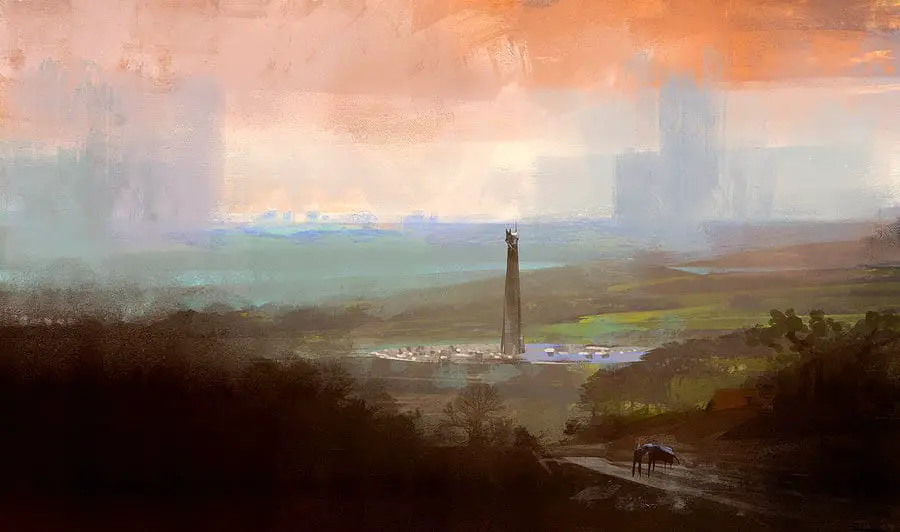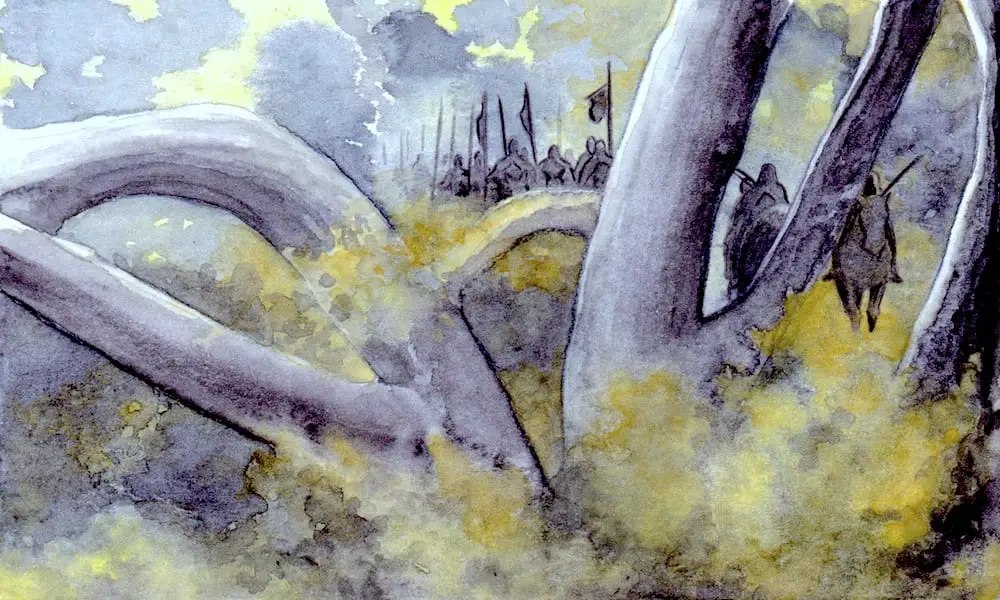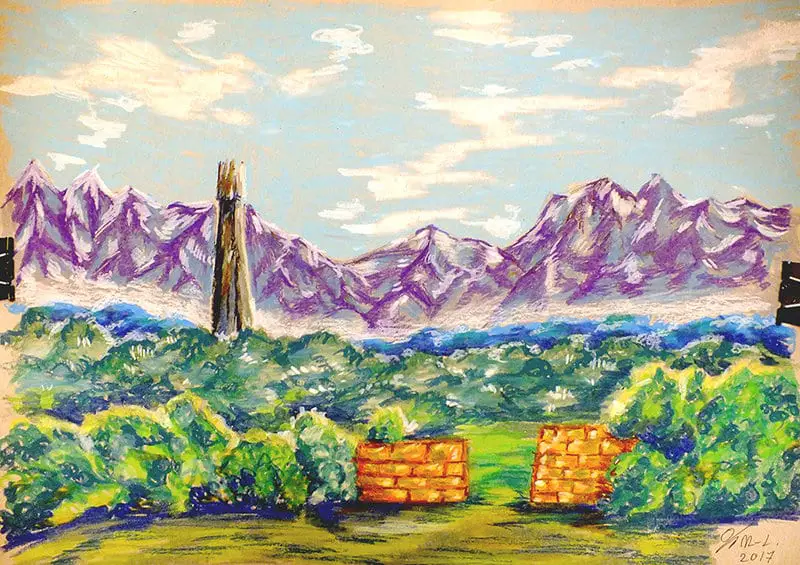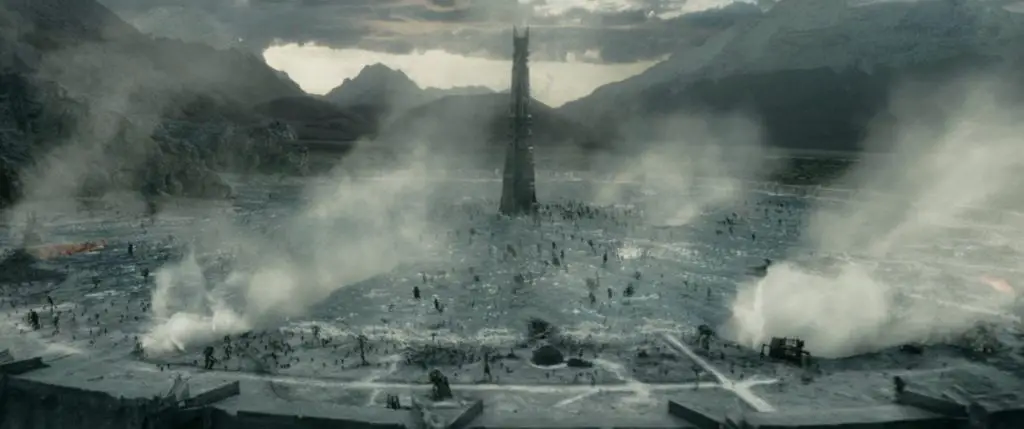We’re roughly at the center point of The Lord of the Rings (though we haven’t reached the end of Book III, by page count we’re a bit over halfway). This doesn’t necessarily mean much, of course – Tolkien doesn’t strike me as the type to construct his work with a Dante-esque obsession with structure. But “The Road to Isengard” feels like a middle point in the story of The Lord of the Rings. A majority of the Fellowship is finally reunited. The immediate threat of Saruman has been neutralized. After chapters and chapters of frantic running around, characters are finally able to stop and take a nap. (Poor Théoden just pulled an all-nighter, something that now devastates my 28-year-old system even when I am not fighting orcs or facing the demise of my people).
But more than that, the road trip to Isengard shows a concern with history and with things to come. Unsurprising for Tolkien, there is a deep respect and awareness of the past – the huorns, the Glittering Caves, the Númenoreans, the Dunlendings. But there is also an awareness of how the past can transform in the present, and become something new in the future. “The Road to Isengard” is a transition chapter. That’s often tossed off as a synonym for “not much happens” or “people walk and talk a lot.” Which is fair. But this chapter is transitional in the more fundamental sense of the term. It’s dwelling on how the past is present, and how it is becoming something else.

The Aftermath of Helm’s Deep
After the sheer scale of Helm’s Deep, particularly its climax, it’s nice to have some breathing room and to check in on the Dunlendings. While the orcs were uniformly routed – either on the field or under the trees – the men who were fighting for Saruman largely surrendered. What follows seems to somewhat surprise everyone involved, and results in a potential pivot point in the relations in the area. Erkenbrand declares the Dunlendings free to go, given that they help bury the dead and swear an oath to not cross the Isen armed. The Dunlendings were amazed, Tolkien notes, “for Saruman had told them that the Men of Rohan were cruel and burned their captives alive.”
It’s a good moment that looks forward and back. The Dunlendings have had a long, contentious relationship to Rohan, with ugly implications for both sides. Helm’s Deep is a marker of this history, given its strong associations with King Helm and his successful repulsion of a Dunlending siege. The entire reason that the Dunlendings are there is the manipulation of their history by Saruman (and his +20 persuasion powers). But the resolution of the battle seems to look ahead more than backwards. It’s a classic Tolkien move – an act of mercy results in long-reaching, unforeseen benefits. The moral arc of Middle-earth bends towards justice, provided no one is too judgey and vindictive.
It’s an interesting way to start out the chapter – there is a sense in this chapter of looking beyond the War with Sauron and Saruman, and implications of what the world could look like after its end.
Trees and Stones
This sense only gets stronger through the rest of “The Road to Isengard.” The Battle of Helm’s Deep was won by our heroes due to a number of reasons. But two of them are old, ancient: the caverns under the White Mountains and the hoard of huorns from Fangorn. The Númenoreans carved out the caverns ages ago; the huorns (and especially their shepherds) are nearly ageless.
The Lord of the Rings – especially The Fellowship of the Ring –trained its readers to see the past as something crystallized. Things of great age are often either stagnant and fading (Lórien), entirely gone (the ruins around Arnor) or closed off, fenced away into isolated little pockets of magic (The Old Forest). The past is an object of nostalgia or a threat, there is a constant sense that ages are ending and time is winding down.
It’s an attitude echoed in this chapter itself. Théoden expresses his sadness to Gandalf, explaining that “however the fortune of war shall go, may it not so end that much that was fair and wonderful shall pass forever out of Middle-earth?” And Gandalf doesn’t disagree. It’s a central part of Tolkien’s style and mythos, and a central part of his popularity. There’s an almost aching sense throughout his writing of those that have passed, and have been lost.

Towers of Shadow
At first, it seems like the huorns marching on Helm’s Deep is just a slight deviation from this general attitude. They’re a bit like a more active, mobile version of The Old Forest, and are delightfully frightening. Legolas describes them as being filled with a great “wrath.” Gimli, despite being saved by their arrival, claims that he cannot bring himself to love them. This seems like a fair assessment! This is the two descriptions we are given of the huorns:
The trees were grey and menacing, and a shadow or a mist was about them. The ends of their long sweeping boughs hung down like searching fingers, their roots stood up from the ground like limbs of strange monsters, and dark caverns opened beneath them.
And:
A mist gathered about them. Above them a few stars still glimmered faintly; but on either side there arose walls of impenetrable gloom; they were in a narrow lane between moving towers of shadow. Voices they heard, whisperings and groanings and an endless rustling sigh; the earth shook under them.
It’s deeply satisfying to just see the trees rise and take revenge, particularly when we see later what Saruman has done to Isengard. It’s great to see Saruman’s arrogance laid low by something ancient and more powerful than him. From one perspective – and the one that seems most common in depictions and discussion of Tolkien – it’s read as Old Nature fighting back against the New Industry of the present. And none of that’s wrong! But I also don’t think it’s a complete picture.
Caves and Huorns
For both Legolas and Gimli, their interactions with the past change them in the present and shape them in the future. When riding out to Isengard, Legolas looks back and the forest of huorns and sees eyes looking out. He starts to ride back (to Gimli’s intense dismay) when Gandalf cries: “Do not go back into the wood, not yet! Now is not your time.”’ But seing something ancient shapes so much of what’s to come for Legolas, who spends much of his time after the War of the Ring visiting Fangorn Forest and then replanting trees in war-torn Ithilien.
Gimli undergoes a similar experience. His description of the Glittering Caves is beautiful on the level of both prose and character. It’s long, but lovely:
There are columns of white and saffron and dawn-rose, Legolas, fluted and twisted into dreamlike forms; they sprung up from many-colored floors to meet the glistening pendants of the roof: wings, ropes, curtains fine as frozen clouds; spears, banners, pinnacles of suspended palaces! Still lakes mirror them: a glimmering world looks up form dark pools covered with clear glass; cities, such as the mind of Durin could scarce have imagined in his sleep, stretch on through avenues and pillared courts, on into the dark recesses where no light can come. And plink! a silver drop falls, and the round wrinkles in the glass make all the towers bend and waver like weeds and coral in the grottos of the sea.
Like Legolas, Gimli doesn’t take his interaction with the past as reason for sadness or loss. After the war, he returned to the Glittering Caves and expanded, hanging lamps to magnify their wonder. In this context, the past is not something that slips away. It is something redolent with potential, something that can be transformative.

The Songs Have Come Down Among Us
And this (like all of Tolkien!) brings us back to stories. Théoden says the following on the road to Isengard:
Long we have tended our beasts and our fields, built our houses, wrought our tools, or ridden away to help in the wars of Minas Tirith. And that we called the life of the Men, the way of the world. We cared little for what lay beyond the borders of our land. Songs we have that tell of these things, but we are forgetting them, teaching them only to children, as a careless custom. And now the songs have come down among us out of strange places, and walk visible under the sun.
These words are so interesting in light of Legolas’s and Gimli’s experiences. They suggest that the problem is not that the past is being lost. It’s that it’s being used and interpreted in the wrong way. People sings songs about the past, or tell these stories to children. But by the end of The Lord of the Rings, Legolas and Gimli use these stories. They are inspired by them and transform the past into something new and vibrant. “The Road to Isengard” is so interesting in this regard. For one of the first times in the story there is a tangible sense of looking past the War of the Ring, and of thinking of what could come next – even in a world whose current age is coming to an end.
Isengard
Before we jump down to final comments, a few quick words on Isengard. It’s also thematically fitting – where our protagonists are thinking of how to listen to and transform the past into something new and fruitful, Saruman bulldozes it. Where Legolas and Gimli show respect and reverence, Saruman clearly has disdain. Isengard – once a beautiful and verdant vale – is full of brambles and thorns and weeds, “silent now but for the stony noise of quick waters.” Once again, Saruman is undone by his imitation. He doesn’t try to creatively transform, he tries to hastily replicate. Trees become copper and iron pillars and Saruman is left not with something new but with “a little copy, a child’s model or a slave’s flattery.” It’s telling that Tolkien likens it to a city of the dead:
Many houses there were, chambers, halls and passages, cut and tunneled back into the walls upon their inner side, so that all the open circle was overlooked by countless windows and dark doors… Shafts were driven deep into the ground; their upper ends were covered by low mounds and domes of stone, so that in the moonlight the Ring of Isengard looked like a graveyard of unquiet dead.
“The Road to Isengard” is a transition chapter in the best sense of the word. It explores what transition is, and as we head towards the later stages of the story it lays the seeds for what comes after. It is a breather of a chapter, but also lightly mines the fundamental layers of The Lord of the Rings: the nature of stories and time, and how the stories of the past can be picked up and used to create a new and different future.

Final Comments
- RIP, Háma. I thought you were lovely and I forgot you died at Helm’s Deep.
- It is so nice to see Merry and Pippin again. I know I’ve said it before, but hobbits inject so much life and energy into this story. M&P are definitely a little drunk / and or high when the rest of the company finds them, right? It’s so nice to see them cheerfully bantering with Gimli, who wants to know how they managed to be sitting around smoking while he’s been sprinting all around Rohan looking for them. Pippin, rightfully, notes that they have every right to have a smoke after having casually brought down the might of Isengard. Fair enough, Pip.
- So did the huorns… eat the orcs? Smash them? I find it super unsettling that the orcs who fled into the woods just disappeared.
- It makes me laugh that the Rohirrim predominantly used the Glittering Caves as a storage facility.
- Prose Prize: Gimli’s description of Aglarond.
- Contemporary to this Chapter: As Théoden and company head out towards Isengard, Frodo and Sam get their first glimpse of the Black Gate of Mordor. The rest of Book III happens on the same day that everyone arrives at Isengard (March 5th). Book IV however, goes much further into the future (March 13th, the same day Aragorn captures the fleet at Pelagir and Faramir is wounded in battle). I hadn’t realized the timelines became quite that disjointed.
Art Credits: Movie stills are from The Lord of the Rings: The Two Towers (2002), courtesy of New Line Cinema. Art, in order of appearance, is courtesy of Michael Allrich, Tomas O. Muir, Peter Xavier Price, and Miruna Lavinia.

